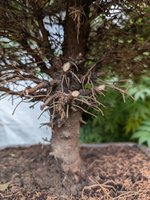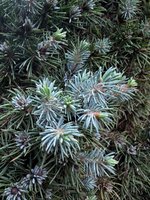I was mainly thinking of just pruning it a small amount in September time to just allow so light inside the tree as all the growth is right at the ends of the needles
Pruning:
Picea have a tendency to throw out whorls of branches, causing swelling and inverse taper.
Therefore you must bring every intersection back to two.
This means:
Trunk + 1 primary branch
Primary branch + 1 secondary branch
You’re going to be stunned about how many branches will need to come off. Don’t be conservative. Now is your only chance to set the tree up for ultimate success. Sacrifice today’s beauty for a greater quality tree down the line.
In your selection of which branches to keep, favour the slim and vigorous branches over:
-slim and weak branches
-thick and vigorous branches
-thick and weak branches
Why?
1) Picea branches take a long time to set with wire. The thinner, the faster they set.
2) Better scale and proportion.
And here’s the kick: Picea backbud wonderfully, but you must prune responsibly.
This means:
- On vigorous branches you can prune back to any visible bud. Always leave a bud on picea branches, or else they will die back,
- On weaker branches do not prune back. Let them elongate. It’s the elongation process which builds the strength for backbudding to occur later on, when you do prune.
Styling:
Ancient Spruce in nature can have long drooping branches, from years of snowload pushing them down. If you like this esthetic you can consider wiring your branches all the way downwards and create multiple pads from the secondary branches that occur along your primary branches.
Wiring should only be done in fall and early spring. Wiring in summer, I have found, can cause branches to die back because it’s too easy to slip the plump bark off.
Let the wire bite in before removing. This is necessary for it to succesfully set the branch.
Even then, each branch will need a second wiring and often a third wiring to hold position.
Hope that helps!




